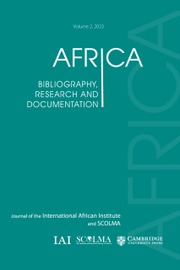Article contents
Nigerian journals, publishers, and libraries: a response to Hans Zell
Published online by Cambridge University Press: 20 December 2024
Abstract
An important and timely recent article by Hans Zell on Nigerian university presses prompts wider questions about the state of Nigerian scholarly publishing, how universities in general and journal publishers in particular adapt, and how libraries access scholarly outputs. This brief response to the article seeks to widen the discussion and encourage further research and action on the subject.
Résumé
Un article récent et important de Hans Zell sur les presses universitaires nigérianes soulève des questions plus larges sur l’état de l’édition universitaire nigériane, sur la manière dont les universités en général et les éditeurs de revues en particulier s’adaptent, et sur la manière dont les bibliothèques accèdent aux productions scientifiques. Cette brève réponse à l’article vise à élargir le débat et à encourager de nouvelles recherches et actions sur le sujet.
Information
- Type
- Journals and book publishing
- Information
- Copyright
- © The Author(s), 2024. Published by Cambridge University Press on behalf of the International African Institute
References
- 1
- Cited by

